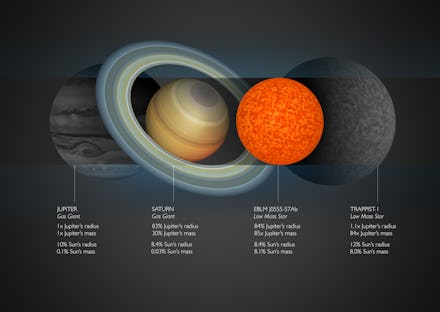Scientists just spotted an adorable star that barely even qualifies

Sometimes, scientists’ categories for things can be a little demeaning. For example: the “failed star” designation for objects that are larger than planets but smaller than stars. About 600 light-years away, EBLM J0555-57Ab just barely missed the failed star category. But as will be published in an upcoming issue of the journal Astronomy & Astrophysics, it’s just a hair over the boundary, making it one of the smallest stars we know of.
“Failed star” is actually a factual statement — it just means something isn’t large enough to manage to bang hydrogen atoms together to form helium, the basic process at the heart of a burning star.
EBLM J0555-57Ab looks a bit like it shouldn’t have made the cut: It’s only a tiny bit larger than Saturn, or about one-twelfth the size of our sun. The team that spotted it actually spends its time looking for planets — they recently discovered seven Earth-sized planets around another unusually small star, the TRAPPIST system.
With stars, though, what really counts is their mass, or how much matter they contain. Despite EBLM J0555-57Ab’s small size, its mass is the equivalent of about 85 Jupiters. That’s just over where scientists think the line between stars and failed stars, also known as brown dwarfs, falls — at about 83 Jupiter-masses for stars with a composition like the new one’s.
The tiny star doesn’t shine very brightly. The scientists only spotted it because it has a companion, a brighter star that it orbits. As EBLM J0555-57Ab passed in front of its companion, the scientists’ instruments measured just a smidge less brightness from that larger star. It’s the same technique astronomers use to identify planets orbiting other stars.
And that could be a very helpful coincidence, since relatively small stars are our best bets for finding planets that resemble Earth. But because small stars are hard to spot/ We don’t know much about them, so being able to study EBLM J0555-57Ab is an opportunity to help fill that gap.